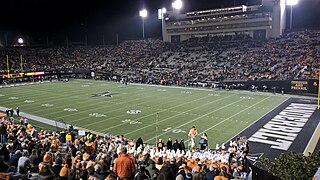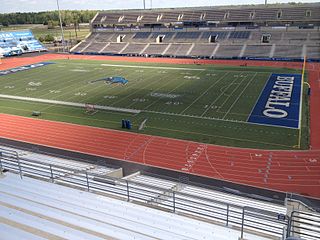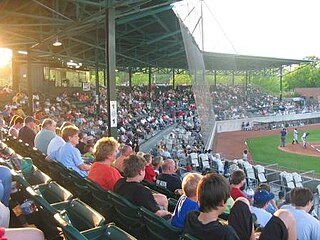
Tampa Stadium was a large open-air stadium located in Tampa, Florida, which opened in 1967 and was significantly expanded in 1974–75. The facility is most closely associated with the Tampa Bay Buccaneers of the National Football League, who played there from their establishment in 1976 until 1997. It also hosted two Super Bowls, in 1984 and 1991, as well as the 1984 USFL Championship Game.

FirstBank Stadium is a football stadium located in Nashville, Tennessee. Completed in 1922 as the first stadium in the South to be used exclusively for college football, it is the home of the Vanderbilt University football team. When the venue was known as Vanderbilt Stadium, it hosted the Tennessee Oilers during the 1998 NFL season and the first Music City Bowl in 1998 and also hosted the Tennessee state high school football championships for many years.

Jordan–Hare Stadium is the playing venue for the Auburn University Tigers football team located on campus in Auburn, Alabama. The stadium is named for Ralph "Shug" Jordan, who owns the most wins in school history, and Cliff Hare, a member of Auburn's first football team as well as Dean of the Auburn University School of Chemistry and President of the Southern Conference. On November 19, 2005, the playing field at the stadium was named in honor of former Auburn coach and athletic director Pat Dye. The venue is now known as Pat Dye Field at Jordan–Hare Stadium. The stadium reached its current seating capacity of 87,451 with the 2004 expansion and is the 10th largest stadium in the NCAA. For years, it has been a fixture on lists of best gameday atmospheres and most intimidating places to play.

Ben Hill Griffin Stadium, popularly known as "The Swamp", is a football stadium on the campus of the University of Florida in Gainesville and the home field of the Florida Gators football team. It was originally known as Florida Field when it opened as a 22,000 seat facility in 1930, and it has been expanded and renovated many times over the ensuing decades. Most of the university's athletic administrative offices, along with most football-related offices and training areas, have been located in the stadium since the 1960s. Most of the football program's facilities are slated to move to a nearby $60 million building that began construction in 2020.

Dix Stadium is a multi-purpose stadium in Kent, Ohio, United States. It is primarily used for American football, and is the home field of the Kent State Golden Flashes football team. In addition, since 2016 the stadium is also home to the Kent State women's soccer team and since 2019 to the women's lacrosse team. Previously, it was home to the Kent State field hockey team from 1997 to 2004 and served as a secondary home for the KSU men's soccer team in the 1970s. It opened on September 13, 1969 and was named in 1973 after Robert C. Dix, former publisher of the Record-Courier and a member of Kent State's Board of Trustees for more than three decades. It was built as an expansion and relocation of Memorial Stadium, with all of Memorial Stadium's main seating areas used at the current stadium in a new configuration.

UB Stadium is a stadium in Amherst, New York on the campus of the University at Buffalo. It is primarily used for football, soccer, and track and field events, and is the home field of the Buffalo Bulls. It opened on September 4, 1993, with a game against the University of Maine.

Grainger Stadium is a sports venue located in Kinston, North Carolina. It is the home ballpark for the Down East Wood Ducks, which joined the Carolina League starting in the 2017 season, and was placed in the Low-A East for the 2021 season. Grainger was previously home to the Kinston Indians and all the professional Kinston baseball teams since 1949.
Alfred A. McKethan Stadium at Perry Field was the college baseball stadium of the University of Florida, serving as the home field for the Florida Gators baseball team until being replaced by Florida Ballpark in 2020. McKethan Stadium was located on the university's Gainesville, Florida campus, in close proximity to the university's indoor sports arena, the Stephen C. O'Connell Center, and its football stadium, Ben Hill Griffin Stadium.

Jack Coffey Field is a 7,000-seat multi-purpose stadium in the northeast United States, located on the campus of Fordham University in The Bronx, New York. It is the Fordham Rams' home for football, men's and women's soccer, and baseball. The facility opened for baseball 92 years ago in 1930, and was named in 1954 for baseball coach and longtime athletic director Jack Coffey, four years before his 1958 retirement.

Wendel D. Ley Track and Holloway Field is a stadium in Houston, Texas. It is primarily used for track and field and soccer for the Rice University Owls. It is bounded by Main Street (southeast), University Boulevard (southwest), Reckling Park baseball field (west) and open athletic fields (north).

North Texas Mean Green represents the University of North Texas (UNT) in intercollegiate athletics. The teams compete in Division I of the National Collegiate Athletic Association (NCAA). North Texas competed in the Sun Belt Conference until joining Conference USA (C-USA) on July 1, 2013. UNT's official school colors are Green and White. North Texas' mascot is an Eagle named Scrappy.

The North Texas Mean Green football program is the intercollegiate team that represents the University of North Texas in the sport of American football. The Mean Green compete in the Football Bowl Subdivision (FBS) of the National Collegiate Athletic Association (NCAA) and the West Division of Conference USA (CUSA). They are coached by Seth Littrell, who has served in that position since 2016. North Texas has produced 24 conference championship titles, with twelve postseason bowl appearances and four appearances in the former I-AA Playoffs. The Mean Green play their home games at the Apogee Stadium which has a seating capacity of 30,850.

Apogee Stadium is a college football stadium located at the junction of Interstate 35 East and West in Denton, Texas. Opened in 2011, it is home to the University of North Texas (UNT) Mean Green football team, which competes in Conference USA. The facility replaced Fouts Field, where the school's football program had been based since 1952.

Memorial Stadium was a multi-purpose stadium in Kent, Ohio, United States, on the campus of Kent State University. Its primary use was as the home field for the Kent State Golden Flashes football team and also served as the home venue for the KSU men's track and field team. The football and track teams had already been playing on the site since 1941, but with temporary bleachers for seating. The permanent grandstand built and dedicated in 1950, which also included a press box, was the first phase of the stadium, and was later followed by a duplicate grandstand on the opposite side of the field in 1954. Initial plans called for the seating to eventually surround the field, though these plans were largely never realized. During the 1960s, additional bleacher seats were added separate from the two main grandstands on all sides of the field, and brought seating capacity to approximately 20,000 by 1965.

The 2010 North Texas Mean Green football team represented the University of North Texas as a member of the Sun Belt Conference during the 2010 NCAA Division I FBS football season. The Mean Green began the season under fourth-head coach Todd Dodge, who was fired after the team started the season with a 1–6 record. Offensive coordinator Mike Canales was appointed interim head coach and led the team for the final five games of the season. North Texas finished the year with an overall record of 3–9 and a conference mark of 3–5, placing in a three-way tie for sixth in the Sun Belt. The Mean Green played home games on campus at Fouts Field in Denton, Texas. This was the team final season at Fouts Field as the team moved to the newly-opened Apogee Stadium in 2011.

The Safeway Bowl is the name given to the North Texas–SMU football rivalry. It is a college football rivalry game between the Southern Methodist University Mustangs football team and the University of North Texas Mean Green football team, two universities in Dallas–Fort Worth metroplex.
The 1977 North Texas State Mean Green football team represented North Texas State University—now known as the University of North Texas—during the 1977 NCAA Division I football season. In its fifth season under head coach Hayden Fry, the team compiled a 10–1 record. The team played its home games at Fouts Field in Denton, Texas.
The 1976 North Texas State Mean Green football team represented North Texas State University—now known as the University of North Texas—during the 1976 NCAA Division I football season. In its fourth season under head coach Hayden Fry, the team compiled a 7–4 record. The team played its home games at Fouts Field in Denton, Texas.
The 1999 North Texas Mean Green football team represented the University of North Texas in the 1999 NCAA Division I-A football season. The Mean Green played their home games at the Fouts Field in Denton, Texas, and competed in the Big West Conference. They were led by second-year head coach Darrell Dickey. The team finished the regular season with a 2–9 overall record and a 1–5 mark in Big West play.
The 1995 North Texas Mean Green football team represented the University of North Texas in the 1995 NCAA Division I-A football season. The Mean Green played their home games at the Fouts Field in Denton, Texas, and competed as an Independent. They were led by second-year head coach Matt Simon. The team finished the regular season with a 2–9 record.
















